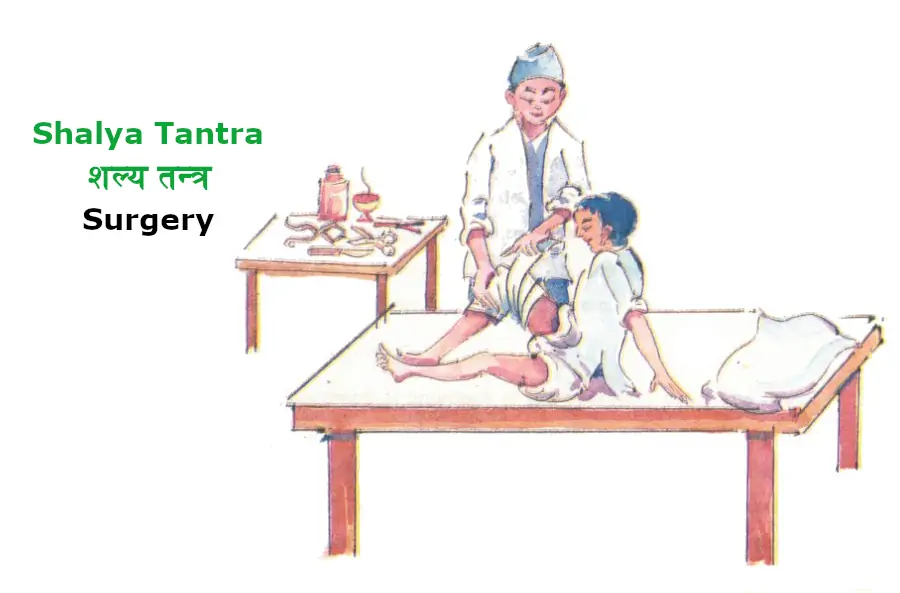Introduction: Shalya Tantra
Shalya Tantra, in Sanskrit शल्य तन्त्र, the section of Surgery follows the school of Dhanwantari Divodasa. The ancient Ayurvedic book, Susruta Samhita is one of the best texts for study. Ayurvedic surgery deals with 1) pre-operation cures, 2) operative surgery, 3) post-operation cures, and 4) emergency treatments. The pre-operation cures are concerned with all medical practices to avoid operation. The operative surgery includes excision, incision, breaking, scratching, detecting, opening, punching, and stitching. The post-operation cures concern cleaning, healing, bandage, protection, and diet. The emergency treatments are related to traumatic injuries, fractures, etc.
Pre-Operation Cures
The practical approach of pre-operation cures has twelve different medical practices. These practices include fasting, proper diet, use of medical plasters, fomentation of medicinal decoction, oil massage, hot compress including steam, rolling pressure, hot poultice, pus forming plaster, blood-letting practice, grease, emetics, and laxatives. The main aim of these practices is to avoid operations dealing with primitive stages of abscess, boils, etc.
Operative Surgery
The practical field of operative surgery is classified into eight different manual works. These works depend upon the different nature of surgical cases. The cases of radical operation of excision are fistula, hemorrhoids, condyloma, warts, com, mole, pterygium, cancer, cyst, tumor, angioma, fibroma, myoma, lipoma, epithelioma, carcinoma, gangrene, polyps, nodules, etc.
Boils, abscesses, bubo, carbuncle, infected glands, sty, chalazion, folliculitis, gingivitis, etc are cases of minor operation or incision.
The breaking operation, or the operation without surgical instruments depends upon the cases of vital places, fearful patients, and weak patients. In this condition, medical applications are used to break the abscess, etc for healing.
Diphtheria, tonsilitis, epiglottitis, leukoderma, scars, labiopathies, glossitis, tartar, trachoma, chalazion, melanoma, blepharitis, xanthelasma, etc the cases of scratching operation. The detecting operation depends upon the cases of sinus, fistula, attached foreign body inside the organ, etc.
The cases of lithiasis, difficult labor, attached foreign body, etc are the subjects of opening and getting out operation. Leprosy, eczema, scabies, ringworm, erysipelous, impetigo, boils, abscess, gingivitis, pyorrhea, periodontitis, glossitis, venereal diseases, blood toxemia, gout, cancer, cyst, tumor, elephantiasis, scrofula, diseases of the lips, ascites hydrocele, etc are the cases of punching operation, blood-letting practices, and fluid get out.
The stitching operation depends upon the condition of traumatic wounds, separated organs, opened wounds of excision, etc.
Post-Operation Cures
The practical field of post-operation cures includes different kinds of purification, healing drugs, restoring the normal stage, and supplementary treatments. The use of poultice, decoction, pills, powder, ghee, oil, paste, sprinkles, incense, leaf bandage, anthelmintic drugs, anti-poison drugs, general tonic, burning practices, enema, etc are the medical approaches for complete cure.
Emergency Treatment
The emergency treatments dealing with traumatic injuries, fractures, dislocation, etc include coagulating drugs to stop bleeding, cooling drugs to relieve pain, healing drugs, supporting instruments to fix the fracture, etc.
Author
Dr. Mana Bajra Bajracharya
PIYUSHABARSHI AUSHADHALAYA
Ayurvedic Clinic
Mahabouddha, Kathmandu, Nepal
For any inquiries or questions, please contact us
Copyright © AyurvedicClinic.Net. All rights reserved. Republishing and copying without authorization is prohibited.

